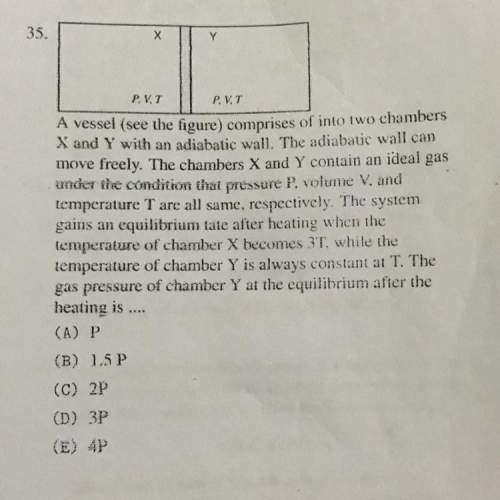
Physics, 12.07.2019 15:10, SilverTheAmarok
Avessel (see the figure) comprises of into two chambers
x and y with an adiabatic wall. the adiabatic wall can
move freely. the chambers x and y contain an ideal gas
under the condition that pressure p, volume v, and
temperature t are all same, respectively. the system
gains an equilibrium fate after heating when the
temperature of chamber x becomes 3t. while the
temperature of chamber y is always constant at t. the
gas pressure of chamber y at the equilibrium after the
heating is


Answers: 1
Other questions on the subject: Physics


Physics, 22.06.2019 08:30, bazsinghnagoke
An automobile steering wheel is shown. what is the ideal mechanical advantage? if the ama is 8, what is the efficiency of the steering wheel?
Answers: 1


Physics, 22.06.2019 15:30, melanieambrosy
To understand the behavior of the electric field at the surface of a conductor, and its relationship to surface charge on the conductor. a conductor is placed in an external electrostatic field. the external field is uniform before the conductor is placed within it. the conductor is completely isolated from any source of current or charge. part a: which of the following describes the electric field inside this conductor? it is in the same direction as the original external field. it is in the opposite direction from that of the original external field. it has a direction determined entirely by the charge on its surface. it is always zero. part b: the charge density inside the conductor is: 0non-zero; but uniformnon-zero; non-uniforminfinite part c: assume that at some point just outside the surface of the conductor, the electric field has magnitude e and is directed toward the surface of the conductor. what is the charge density η on the surface of the conductor at that point? express your answer in terms of e and ϵ0
Answers: 1
Do you know the correct answer?
Avessel (see the figure) comprises of into two chambers
x and y with an adiabatic wall. the ad...
x and y with an adiabatic wall. the ad...
Questions in other subjects:

English, 15.07.2019 20:30

Social Studies, 15.07.2019 20:30

Social Studies, 15.07.2019 20:30

History, 15.07.2019 20:30


Chemistry, 15.07.2019 20:30

Social Studies, 15.07.2019 20:30


Chemistry, 15.07.2019 20:30






